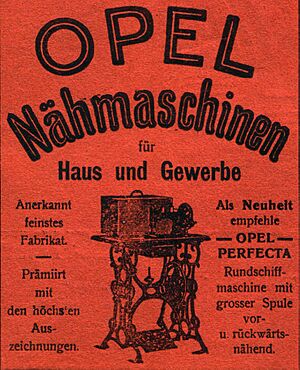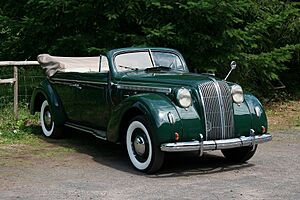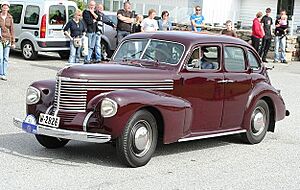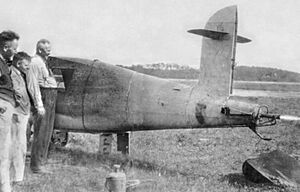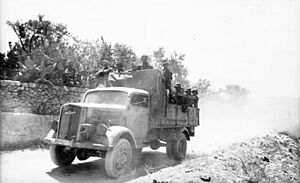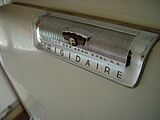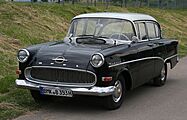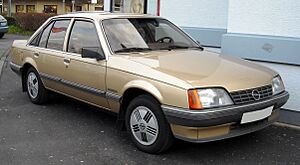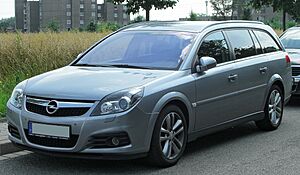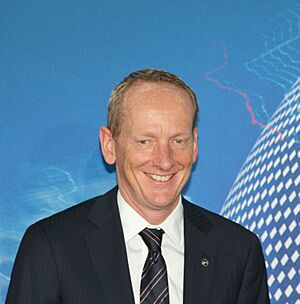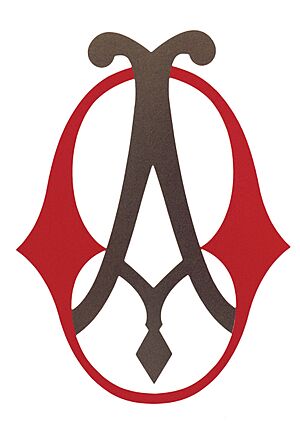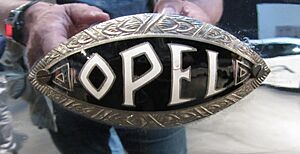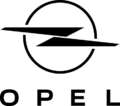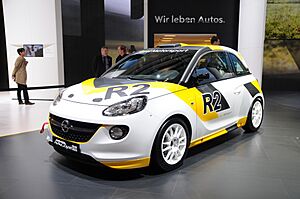Opel facts for kids
 |
|
| Subsidiary | |
| Industry | Automotive |
| Founded | 21 January 1862 |
| Founder | Adam Opel |
| Headquarters |
,
Germany
|
|
Number of locations
|
10 manufacturing facilities |
|
Area served
|
Europe (Vauxhall Motors in the UK), Middle East and Asia-Pacific |
|
Key people
|
Florian Huettl (CEO) |
| Products | Automobiles Electric vehicles Commercial vehicles |
|
Production output
|
|
| Revenue | |
|
Number of employees
|
37,000 (2017) |
| Parent |
|
| Divisions | Opel Performance Center |
| Subsidiaries |
|
Opel Automobile GmbH, usually called Opel, is a German car company. It has been part of Stellantis since January 16, 2021. Before that, it was owned by the American company General Motors from 1929 to 2017. Then, it was part of the PSA Group until 2021.
Many Opel cars are sold as Vauxhall in the United Kingdom. Some Opel cars were also sold under different names in other parts of the world. For example, they were called Holden in Australia, Buick in North America and China, and Chevrolet in South America.
Opel started as a company that made sewing machines in 1862. It was founded by Adam Opel in Rüsselsheim am Main, Germany. The company began making bicycles in 1886. Its first car was built in 1899. Opel also played a big part in early rocket history with the Opel RAK program. This program achieved world speed records and even the first rocket-powered flights in 1928 and 1929.
In 1929, General Motors bought most of Opel. By 1931, GM owned Opel completely. This made Opel a German company owned by an American one for almost 90 years. Opel and British company Vauxhall Motors became the main parts of GM's business in Europe.
In March 2017, the PSA Group bought Opel and Vauxhall from General Motors. This made PSA the second-largest carmaker in Europe. Opel's main office is still in Rüsselsheim am Main. The company designs and builds cars, vans, and parts. Opel and Vauxhall cars are sold in over 60 countries.
Contents
History of Opel Cars

Early Years: Sewing Machines and Bicycles (1862–1898)
Adam Opel started his company in Rüsselsheim, Germany, on January 21, 1862. At first, Opel made sewing machines. In 1886, Opel started selling high-wheel bicycles, also known as penny-farthings. Adam Opel's sons even raced these bicycles to help promote them. By 1888, the company moved to a bigger building. Soon, they made more bicycles than sewing machines. When Adam Opel passed away in 1895, his company was a leader in both markets.
First Cars and Growth (1898–1920)
Opel's first cars were designed in 1898. This happened after Adam Opel's wife, Sophie Opel, and their two oldest sons teamed up with Friedrich Lutzmann. The first Opel car was built in 1899. However, these early cars were not very successful.
In 1901, Opel partnered with a French company called Automobiles Darracq France. They made cars called Opel Darracq. These cars had Opel bodies on Darracq frames with two-cylinder engines.
Opel showed its own car designs at the Hamburg Motor Show in 1902. Production of these Opel-designed cars began in 1906. The Opel Darracq cars were stopped in 1907.
In 1909, Opel made the Opel 4/8 PS model, known as the Doktorwagen (Doctor's Car). Doctors liked this car because it was reliable and strong. It could travel long distances on the rough roads of that time. The Doktorwagen was also affordable, costing about half as much as other luxury cars.
A fire destroyed Opel's factory in 1911. A new factory was built with more modern machines. Opel also built a test track for its cars in 1917. This track, called Opel-Rennbahn (Opel Race Track), opened in 1920.
Mass Production and Rocket Cars (1920–1939)
In the early 1920s, Opel was the first German carmaker to use an assembly line for mass production. In 1924, they used this method to make the Laubfrosch (Tree frog). This car was only sold in green. The assembly line helped make cars more affordable. Opel helped make cars available to more people, not just the rich.
By 1928, Opel had a large share of the German car market. It was also Germany's biggest car exporter. Opel introduced its first eight-cylinder car, the "Regent."
Opel and Fritz von Opel, Adam Opel's grandson, were very important in making rocket-powered vehicles popular. In the 1920s, Fritz von Opel started the Opel-RAK rocket program. This program led to speed records for cars and trains. It also achieved the world's first manned rocket-powered flight in September 1929.
In 1928, Fritz von Opel drove the Opel RAK2 rocket car. He reached a speed of 238 kilometers per hour (148 mph) at a race track in Berlin. Many famous people watched this event. A rail vehicle, the RAK3, reached a top speed of 256 kilometers per hour (159 mph). After these successes, von Opel flew the world's first public rocket-powered plane, the Opel RAK.1. These events created huge excitement around the world.
Opel RAK also worked on liquid-fuel rockets. In April 1929, two liquid-fuel rockets were launched at the Opel Rennbahn. These were the first liquid-fuel rockets in Europe.
The Great Depression ended the Opel-RAK program. In March 1929, General Motors (GM) bought 80% of Opel. GM was impressed by Opel's modern factories. By 1931, GM owned all of Opel.
In 1935, Opel became the first German carmaker to produce over 100,000 cars in a year. This was thanks to the popular Opel P4 model. Opel also made Germany's first mass-produced car with a single-piece steel body, the Olympia, in 1935. This design made cars lighter and more fuel-efficient.
By 1937, Opel's factory in Rüsselsheim was Europe's top car production site. In 1938, Opel introduced the successful Kapitän. Production of cars stopped in October 1940 due to World War II.
World War II and Rebuilding (1940–1970)
During World War II, Opel stopped making cars. Instead, it made aircraft parts and tanks. Truck production continued at the Brandenburg plant. The Opel Blitz truck was also built by other companies under license.
After the war, the Brandenburg plant was taken apart and moved to the Soviet Union. Almost half of the buildings in Rüsselsheim were destroyed. Former Opel employees began rebuilding the Rüsselsheim plant. The first postwar Opel Blitz truck was finished on July 15, 1946. Opel's Rüsselsheim plant also made Frigidaire refrigerators in the early years after the war.
The Opel GT, a two-seater sports car, was introduced in 1968. It was produced until 1973.
Modern Era (1970–2017)
During the 1970s and 1980s, Opel and Vauxhall cars became very similar across Europe. For example, the 1973 Opel Kadett was sold as the Vauxhall Chevette in the UK. The Opel Ascona was sold as the Vauxhall Cavalier.
By the 1970s, Opel was stronger than Vauxhall in Europe. GM decided to combine the operations of Opel and Vauxhall. By the 1980s, the two brands were almost the same.
Opel's first front-wheel drive car, a new version of the Kadett, started production in 1979. It was sold as the Astra in the UK.
In the 1980s, Opel opened a new factory in Spain. Its first car was the Opel Corsa, which was sold as the Vauxhall Nova in the UK. The Ascona became front-wheel drive in 1981. The Kadett was updated again in 1984 and won the European Car of the Year award. The Opel Omega won the same award two years later.
The Ascona name was stopped in 1988. Its replacement was the Vectra. The Opel Manta coupe was also stopped in 1988. Its replacement, the Calibra, launched the next year. Opel also made a very fast version of the Omega, called the Lotus Omega.
Opel's first car with a turbocharger was the Opel Rekord 2.3 TD, shown in 1984.
In the 1990s, Opel was very profitable for GM. Its profits helped GM in other parts of the world. However, 1999 was the last year Opel was profitable for a full year.
The 1991 Astra replaced the Kadett name. Opel also started selling SUVs like the Frontera and Monterey. In 1992, a new Corsa was launched.
A second-generation Omega was launched in 1994. The Tigra coupe was also launched around this time. The second-generation Opel Vectra was launched in 1995.
Opel's first MPV (Multi-Purpose Vehicle), the Sintra, was launched in 1996. It was stopped after three years due to low sales. The Calibra coupe was stopped in 1997.
The Opel Astra was updated in 1998. It later led to coupe, convertible, and compact MPV versions, like the Zafira. In 1999, Opel launched its first sports car, the Speedster. In 2000, Opel entered the city car market with the Agila.
New versions of the Corsa (2000), Vectra (2002), and Astra (2004) were launched. The Insignia replaced the Vectra in 2008. It won the European Car of the Year award.
After the 2008 financial crisis, GM almost sold Opel. But the deal was called off. Opel closed its Antwerp plant in Belgium by the end of 2010. Opel invested a lot of money in new engines and transmissions.
In 2012, Opel announced a partnership with PSA Peugeot Citroen. This was meant to save money. However, GM later sold its share in PSA. Opel's plant in Bochum closed in December 2014. Opel also left the Chinese market in early 2015.
Opel Today (2017–present)
In March 2017, the PSA Group bought Opel and Vauxhall from General Motors. The deal was completed in August 2017. In 2018, Opel made a profit for the first time since 1999.
On January 16, 2021, Opel became part of Stellantis. This happened after PSA Group merged with Fiat Chrysler Automobiles. In September 2021, Uwe Hochgeschurtz became Opel's CEO. Florian Huettl became CEO in June 2022.
Opel Company Details
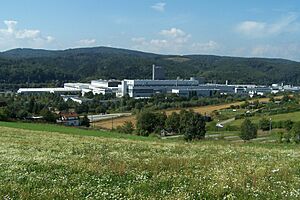
Opel has 10 factories for vehicles, engines, and parts. It also has four development and test centers in six countries. Around 30,000 people work for Opel in Europe. The brand sells cars in over 60 markets worldwide.
Opel's main office and a large technical development center are in Rüsselsheim. Other plants are in Eisenach and Kaiserslautern, Germany; Szentgotthárd, Hungary; Figueruelas, Spain; Gliwice, and Tychy, Poland; Aspern, Austria; Ellesmere Port, and Luton, United Kingdom. The Dudenhofen Test Center is near the headquarters. It handles all technical testing.
About 6,250 people work on engineering and design for Opel and Vauxhall cars. Opel plays a big role in Stellantis' research and development.
Opel Leadership
| Name | From | To |
|---|---|---|
| Edward W. Zdunek [de] (Gaston de Wolff, acting chairman) | November 1948 | February 1961 |
| Nelson J. Stork | February 1961 | March 1966 |
| L. Ralph Mason | March 1966 | 1970 |
| Alexander Cunningham | 1970 | January 1974 |
| John P. McCormack | February 1974 | February 1976 |
| James F. Waters | March 1976 | August 1980 |
| Robert C. Stempel | September 1980 | February 1982 |
| Ferdinand Beickler | February 1982 | February 1986 |
| Horst W. Herke | February 1986 | March 1989 |
| Louis Hughes | April 1989 | June 1992 |
| David Herman | July 1992 | June 1998 |
| Gary Cowger | June 1998 | October 1998 |
| Robert Hendry | October 1998 | March 2001 |
| Carl-Peter Forster | April 2001 | June 2004 |
| Hans Demant | June 2004 | January 2010 |
| Nick Reilly | January 2010 | March 2011 |
| Karl-Friedrich Stracke | April 2011 | July 2012 |
| Thomas Sedran (interim chairman) | July 2012 | February 2013 |
| Dr. Karl-Thomas Neumann | March 2013 | June 2017 |
| Michael Lohscheller | June 2017 | September 2021 |
| Uwe Hochgeschurtz | September 2021 | May 2022 |
| Florian Huettl | Since June 2022 |
Opel Marketing and Identity
Opel Logo Evolution
When Adam Opel started his company in 1862, he made sewing machines. The first logo had a bronze "A" for Adam and a red "O" for Opel.
In 1886, Opel started making bicycles. Around 1890, the logo changed completely. It included the words "Victoria Blitz," meaning "Victory Lightning." The word "Blitz" (lightning) appeared then, but without a picture of lightning.
Another new logo came out in 1909. It was more lively and only had the name "Opel." This logo was used on motorcycles and cars.
In 1910, the logo looked like an eye surrounded by laurels. The word "Opel" was in the middle.
From the mid-1930s to the 1960s, Opel cars had a ring with a flying object through it. This object looked like a zeppelin, an arrow, an airplane, or a bird. It was also used as a hood ornament.
Opel also used a coat of arms, often in white and yellow. This yellow color is still typical for Opel today.
The lightning bolt in the Opel logo comes from the Opel Blitz truck. "Blitz" means "lightning" in German. This truck was very successful. The original logo for the truck had two stripes like a lightning symbol with "Opel" and "Blitz" written on them. Later, in the 1950s, it became a simple horizontal lightning bolt.
By the late 1960s, the flying object in the ring was replaced by the horizontal lightning bolt. This created the basic design used ever since. The logo is simple and easy to recognize.
In 1964, the lightning with a ring was placed in a yellow rectangle. The word "Opel" was below it. The basic shape of the Blitz logo has been the same since 1970.
- Evolution of hood ornament flying through ring
- The lightning of the Opel Blitz replacing the hood ornament
Slogans and Partnerships
Opel's slogan since June 2017 is The Future Is Everyone's. Past slogans included "Fresh thinking – better cars" and "Discover Opel."
Opel partners with football clubs like Borussia Dortmund and 1. FSV Mainz 05. Opel also works with TotalEnergies on battery cell factories. Opel has sponsored many football clubs in the past, such as AC Milan and FC Bayern Munich.
Opel Around the World
Opel cars are sold in most of Europe, parts of North Africa, South Africa, the Middle East, Chile, Colombia, Ecuador, Uruguay, Japan, Singapore, Taiwan, and New Zealand.
Opel models have been sold under different names in other countries. For example, they were Vauxhall in Great Britain, and previously, Chevrolet in Latin America, Holden in Australia and New Zealand, and Saturn in the United States and Canada.
After Saturn closed, Opel cars were sold as Buick in the United States, Canada, Mexico, and China. Examples include the Opel Insignia as the Buick Regal and the Opel Mokka as the Buick Encore.
North America
United States
Opel cars were sold under their own name in the U.S. from 1958 to 1975. They were sold through Buick dealers. Popular models included the Opel Kadett, Opel Manta, and Opel GT.
Later, Opel vehicles were sold under other GM brands in North America. For example, the Buick Regal (fifth and sixth generations) was a version of the Opel Insignia. The Buick Cascada was an Opel Cascada. The Saturn Astra (2008–2009) was an Opel Astra H. The Saturn L-Series (2000–2005) was a modified Opel Vectra B. The second-generation Saturn VUE (2008–2010) was an Opel Antara. The Cadillac Catera (1997–2001) was an Opel Omega B.
Africa and Oceania
Opel exports cars to Algeria, Egypt, Morocco, South Africa, and Tunisia. In South Africa, Opel models were produced by Delta Motor Corporation from 1986 to 2003.
Many Opel models have been sold in Australia and New Zealand as Holden cars. The Opel brand was introduced to Australia in 2012 but stopped exports in 2013 due to low sales. Opel returned to New Zealand in 2022.
Asia
Opel left China in 2015. Opel was sold in Japan until 2006 and returned in 2022. Opel cars are also exported to Singapore. Opel was sold in Malaysia until 2003 and in India until 2006. In Indonesia, Opel cars were produced from 1938. The Opel brand was replaced by Chevrolet in Indonesia in 2002. Opel was also sold in Thailand and the Philippines but was later replaced by Chevrolet. Opel returned to Taiwan in 2022.
South America
Many Opel models were sold in Latin America, especially Brazil and Argentina, under the Chevrolet brand. These included the Corsa, Kadett, Astra, and Omega. Opel now exports cars to Chile, Colombia, Ecuador, and Uruguay.
Europe
United Kingdom
Vauxhall Motors is Opel's sister brand in the UK.
Ireland
In the 1980s, Opel became the only GM brand in Ireland. Opel cars were assembled in Ireland in the 1960s.
Awards and Recognition
Opel has won the European Car of the Year award five times:
- 1985: Opel Kadett E
- 1987: Opel Omega A
- 2009: Opel Insignia
- 2012: Opel Ampera
- 2016: Opel Astra K
Several other Opel models have been nominated for the award.
Opel Car Names
From the 1930s to the 1980s, Opel often used names from the German Navy for its car models. Examples include Kapitän, Admiral, and Kadett. Other names came from official sectors, like Diplomat and Senator.
Since the late 1980s, most Opel passenger car names end with an "a." This happened as Opel and Vauxhall cars became more similar. The Opel Kadett became the Opel Astra in Europe. The Opel Corsa was known as the Vauxhall Nova in Great Britain until 1993.
Some Opel car names do not end with an "a." These include the Speedster, GT, Signum, Karl, and Adam.
Opel also uses "Caravan" for its station wagon models. This practice stopped with the 2008 Insignia and 2009 Astra. Now, the station wagon versions are called "Sports Tourer."
Current Opel Models
The following tables show Opel cars and vans that are currently in production as of 2024:
| Corsa (Production: 1982–present) |
 |
Small car |
|
| Astra (Production: 1991–present) |
 |
Family car |
|
| Frontera (Was previously a rebadged Isuzu MU from 1991 to 2004) (Production: 1991–2004 (original), 2024–present (revival)) |
 |
Mid-size SUV (original) Small crossover SUV (revival) |
|
| Zafira Life (A rebadged Peugeot Traveller/Citroën SpaceTourer) (Production: 1999–present) |
 |
Minivan |
|
| Mokka (Production: 2012–present) |
 |
Small crossover SUV |
|
| Grandland (Production: 2017–present) |
 |
Compact crossover SUV |
|
| Combo Life (A rebadged Peugeot Rifter/Citroën Berlingo) (Production: 2018–present) |
 |
Leisure activity vehicle |
|
| Rocks (A rebadged Citroën Ami) (Production: 2021–present) |
 |
Quadricycle |
|
Light Commercial Vehicles (Vans)
| Combo (A rebadged Peugeot Partner/Citroën Berlingo) (Production: 1986–present) |
 |
Panel van |
|
| Movano (A rebadged Fiat Ducato) (Production: 1998–present) |
 |
Light commercial vehicle |
|
| Vivaro (A rebadged Peugeot Expert/Citroën Jumpy) (Production: 2001–present) |
 |
Light commercial vehicle |
|
Motorsports and Racing
The Opel Rally Team competed in the World Rally Championship in the early 1980s. They used the Opel Ascona 400 and Opel Manta 400. Walter Röhrl won the 1982 World Rally Championship drivers' title.
In the 1990s, Opel raced in the Deutsche Tourenwagen Meisterschaft (German Touring Car Championship). They won the 1996 championship with the Calibra. Opel also participated in the Super Tourenwagen Cup and won in 1998. Opel raced in the German DTM series from 2000 to 2005. They won several races in 2000. Opel also won the Nürburgring 24 Hours race with the Astra in 2003.
Opel returned to racing with the Adam in 2013. In 2014, Opel showed a street-legal sports version of the Adam R2 Rally Car.
In 2019, Opel introduced the Corsa Rally Electric. This is an electric rally car for customer racing. Opel and ADAC started the ADAC Opel Electric Rally Cup in 2021. This is the world's first rally series for electric cars. The electric parts come from the production Corsa car.
See also
 In Spanish: Opel para niños
In Spanish: Opel para niños
- Fritz von Opel
- Rikky von Opel
- Wilhelm von Opel
- Irmscher
- Steinmetz Opel Tuning
- IDA-Opel
- List of German cars


